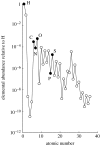Electrons, life and the evolution of Earth's oxygen cycle
- PMID: 18487127
- PMCID: PMC2606772
- DOI: 10.1098/rstb.2008.0054
Electrons, life and the evolution of Earth's oxygen cycle
Abstract
The biogeochemical cycles of H, C, N, O and S are coupled via biologically catalysed electron transfer (redox) reactions. The metabolic processes responsible for maintaining these cycles evolved over the first ca 2.3 Ga of Earth's history in prokaryotes and, through a sequence of events, led to the production of oxygen via the photobiologically catalysed oxidation of water. However, geochemical evidence suggests that there was a delay of several hundred million years before oxygen accumulated in Earth's atmosphere related to changes in the burial efficiency of organic matter and fundamental alterations in the nitrogen cycle. In the latter case, the presence of free molecular oxygen allowed ammonium to be oxidized to nitrate and subsequently denitrified. The interaction between the oxygen and nitrogen cycles in particular led to a negative feedback, in which increased production of oxygen led to decreased fixed inorganic nitrogen in the oceans. This feedback, which is supported by isotopic analyses of fixed nitrogen in sedimentary rocks from the Late Archaean, continues to the present. However, once sufficient oxygen accumulated in Earth's atmosphere to allow nitrification to out-compete denitrification, a new stable electron 'market' emerged in which oxygenic photosynthesis and aerobic respiration ultimately spread via endosymbiotic events and massive lateral gene transfer to eukaryotic host cells, allowing the evolution of complex (i.e. animal) life forms. The resulting network of electron transfers led a gas composition of Earth's atmosphere that is far from thermodynamic equilibrium (i.e. it is an emergent property), yet is relatively stable on geological time scales. The early coevolution of the C, N and O cycles, and the resulting non-equilibrium gaseous by-products can be used as a guide to search for the presence of life on terrestrial planets outside of our Solar System.
Figures



References
-
- Allen J.F, Martin W. Out of thin air. Nature. 2007;445:610–612. doi:10.1038/445610a - DOI - PubMed
-
- Aller R.C. Mobile deltaic and continental shelf muds as fluidized bed reactors. Mar. Chem. 1998;61:143–155. doi:10.1016/S0304-4203(98)00024-3 - DOI
-
- Altabet, M. 2006 Isotopic tracers of the marine nitrogen cycle: present and past. In Marine organic matter: biomarkers, isotopes and DNA, vol. 2N/2006 (ed. J. K. Volkman), pp. 251–293. Berlin, Germany: Springer.
-
- Altabet M.A, Murray D.W, Prell W.L. Climatically linked oscillations in Arabian Sea denitrification over the past 1 m.y.: implications for the marine N cycle. Paleoceanography. 1999;14:732–743. doi:10.1029/1999PA900035 - DOI
-
- Anbar A.D, Knoll A.H. Proterozoic ocean chemistry and evolution: a bioinorganic bridge? Science. 2002;297:1137–1142. doi:10.1126/science.1069651 - DOI - PubMed
Publication types
MeSH terms
Substances
LinkOut - more resources
Full Text Sources
Other Literature Sources

